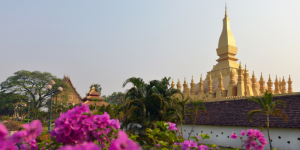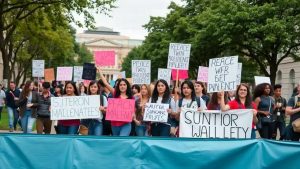Long Tieng: The Untold Story of America’s Covert War in Laos
By: Emilly Correa Posted in: junho 9, 2025

Anúncios
Introduction: The Legacy of Long Tieng – A Forgotten Chapter of the Cold War
Tucked away in the heart of Laos, deep within the dense, sweltering jungles, lies a relic of the past that few outside of historical circles have come to know. Long Tieng, once a critical CIA base during the Cold War, now stands as a quiet, rural village.
However, beneath its peaceful facade lies a significant part of the United States’ covert operations in Southeast Asia. The village was once home to the “most secret place on Earth,” as it served as the epicenter of a covert CIA operation known as the Secret War.
Long Tieng’s airstrip, though now neglected and cracked, was once among the busiest in the world.
In its prime, it hosted hundreds of flights daily, supporting a secret army, international supply chains, and missions that would alter the course of history.
Anúncios
Today, this airstrip lies silent, a poignant reminder of a conflict long forgotten by most.

The Remote Village of Long Tieng: A Snapshot of the Present
Long Tieng is a small village located approximately 80 miles northeast of Laos’ capital, Vientiane. Despite its proximity to the capital, the village is often isolated, with few visitors and limited access to modern amenities.
Anúncios
The village’s population, which consists of a few thousand residents, primarily relies on agriculture for sustenance.
The landscape is dotted with small farms and simple shops that sell a variety of goods, from rice to farming tools made from repurposed materials.
The village’s airstrip, once bustling with activity, now serves as a communal space where children ride scooters, farmers herd cattle, and elderly locals take early morning walks before the valley’s intense heat takes over.
However, this peaceful scene belies the dramatic and tumultuous history that unfolded here just 50 years ago. 🌄
A Critical Role in the US’s Secret War in Southeast Asia
Between the 1960s and early 1970s, Long Tieng played a pivotal role in the United States’ efforts to curtail the spread of communism across Southeast Asia.
The airstrip and the surrounding village were the operational hub of a secret army, formed by the US and led by the Hmong people, who fought against the communist Pathet Lao forces, backed by North Vietnam.
The site became the headquarters of the CIA-backed Hmong army, under the leadership of General Vang Pao.
This army, along with US military support, carried out critical missions against North Vietnamese forces, including sabotage operations and guerrilla warfare.
In total, tens of thousands of individuals — Hmong soldiers, their families, refugees, Thai soldiers, and American operatives — called Long Tieng home.
A Hidden and Secretive Base
At the height of the operation, Long Tieng became one of the busiest airstrips in the world, with up to 900 takeoffs and landings each day.
It served as a logistical hub for a vast and intricate network of smaller airstrips scattered throughout Laos.
Cargo planes brought in critical supplies such as food and ammunition, which were then offloaded onto smaller planes to continue their journey to remote outposts across the country.
The operation was so secretive that even many of those participating in the broader war effort were unaware of Long Tieng’s existence.
According to Paul Carter, a Laos Secret War expert, the compartmentalization of the war kept even the most well-informed personnel in the dark about the operations in Long Tieng until the late 1960s.
The Importance of Long Tieng: Strategic Airstrips and Covert Operations
Long Tieng’s strategic importance went far beyond its role as an airstrip.
It was the center of a vast covert network that spanned Laos and Vietnam, where the CIA and its operatives supported not only the Hmong army’s combat efforts but also carried out crucial missions such as:
| Tactic | Description |
|---|---|
| 💣 Destroy Supply Depots | Targeting North Vietnamese storage facilities to limit enemy resources. |
| 🛣️ Disrupt Supply Routes | Blowing up key roads and trails, including the Ho Chi Minh Trail. |
| 🧠 Psychological Warfare | Spreading propaganda to lower enemy morale and encourage defection. |
The success of these operations would not have been possible without the airstrip, which served as a lifeline for the CIA’s paramilitary operations.
The constant stream of cargo planes and military flights facilitated these operations, which were essential for the success of the broader effort to prevent the spread of communism.
The Secret War and the Role of the CIA
Laos, a neutral country according to international agreements, was not meant to be directly involved in the Vietnam War.
However, the US’s covert operations in Laos, particularly the bombing campaigns, were essential in undermining the communist forces.
The bombing campaign conducted by the US was extensive, dropping millions of tons of bombs on Laos, much of which was done by US Air Force pilots operating out of Long Tieng.
The airstrip itself had codenames such as Lima Site 98 and Lima Site 20A during the war.
In addition to CIA-backed operations, the US also utilized Air America, a secret airline owned by the CIA, to carry out essential missions to Long Tieng.
These missions included airlifts of supplies, search and rescue operations, and the transportation of key personnel behind enemy lines.
The Journey to Long Tieng: Revisiting a Forgotten Battlefield
Decades after the fall of Long Tieng in 1975, I set out on a journey to explore the remnants of this secret war.
Fascinated by the hidden history of Long Tieng, I read books like A Great Place to Have a War by Joshua Kurlantzick and watched grainy news footage of reporters visiting the base.
My curiosity grew, and I realized I needed to visit Long Tieng in person to understand its significance better.
The journey to Long Tieng was no easy feat. After arriving in Vientiane, I enlisted the help of Mr. Pao, an experienced driver familiar with the rugged terrain near Long Tieng.
The drive, though only 80 miles from the capital, took over eight hours due to poor road conditions, landslides, and limited visibility caused by dust from mining trucks.
At times, our journey felt perilous, as we navigated mountain passes with sheer drops and precarious roads. 🚗💨
Upon arriving, it was evident that the once-thriving military base had long since been transformed.
The airstrip, which had once witnessed countless daily takeoffs, was now silent.
The area had changed drastically, with farming taking the place of military operations. The landscape, once teeming with soldiers, was now quiet, with only a handful of people and their cattle occupying the land.
Exploring the Legacy of General Vang Pao
Among the most significant remnants of Long Tieng is the former headquarters of General Vang Pao.
Located just 100 meters from the airstrip, the building, surrounded by a high fence and overgrown garden, still stands today.
This compound served as the nerve center of the CIA-backed Hmong army, where General Vang Pao coordinated covert operations with US military advisors.
Inside the compound, the house remains eerily empty, with only a few artifacts of war, such as artillery shells and mortar rounds, scattered around.
The house provides a surreal glimpse into the past, offering a stark contrast between its modest setting and the immense scale of the operations it once oversaw.
Standing at the window, it’s hard to fathom that B-52 bombers were once directed from this very spot to strike communist strongholds.
The quiet beauty of the surrounding landscape now feels distant from the chaos and violence that once permeated the area.
Laos Today: The Lingering Impact of War
Despite the passage of decades, the legacy of the war in Laos is still felt today.
The extensive bombing campaign left behind millions of unexploded ordnance (UXOs) that continue to kill and injure people across the country.
According to the Mines Advisory Group (MAG), around 30% of the bombs dropped during the war failed to detonate, leaving dangerous remnants of war scattered across the landscape.
In Long Tieng and surrounding areas, villagers continue to avoid areas with suspected UXOs, as the risk of death or injury remains high.
The US has invested millions of dollars in bomb clearance efforts, but the work is slow, and the threat remains.
The historical impact of the war continues to shape the lives of those living in its shadow.
The Forgotten War: America’s Secret History in Laos
The story of Long Tieng and the Secret War is a chapter of American history that remains largely forgotten. While the war in Vietnam received widespread attention, the covert operations in Laos were kept hidden from the public for many years.
Today, Long Tieng stands as a reminder of the far-reaching consequences of the Cold War and the secretive operations that took place in the jungles of Southeast Asia.
For those who visit Long Tieng today, it is not just a remote village but a place where history, once shrouded in secrecy, has left an indelible mark on the landscape and the lives of its people.
The remnants of the airstrip, the abandoned military barracks, and the quiet village are all that remain of a forgotten chapter of the war that shaped the region.
Conclusion: The Enduring Legacy of Long Tieng
As I stand on the former airstrip, surrounded by the remnants of a war that ended long ago, I am struck by the sense of loss and the passage of time.
The village of Long Tieng may seem peaceful today, but it holds a legacy that will never be fully forgotten.
Despite the absence of commemoration, the story of Long Tieng remains a testament to the sacrifices made during the Secret War and the profound impact of covert operations during the Cold War.
As the world moves forward, the legacy of Long Tieng serves as a reminder of the complex history that continues to shape the present.
While the airstrip may be silent, the echoes of the past can still be felt in every corner of this once-secret place.
-

Emilly Correa is a journalist with a degree in Digital Marketing, specializing in content production for social media. With experience in advertising copywriting and blog management, she combines her passion for writing with digital engagement strategies. She has worked in media agencies and now focuses on producing informative articles and trend analysis.






